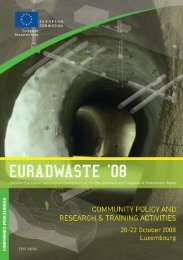EU industrial structure - EU Bookshop - Europa
EU industrial structure - EU Bookshop - Europa
EU industrial structure - EU Bookshop - Europa
Create successful ePaper yourself
Turn your PDF publications into a flip-book with our unique Google optimized e-Paper software.
ox III.3: Unit labour costs<br />
Chapter III — Drivers of Sector Growth and Competitiveness<br />
As presented in Figure III.12., unit labour cost growth is expressed in terms of growth rates of the ratio of labour<br />
compensation (gross wages 44 ) per employee to labour productivity growth (production by employee). Unit labour<br />
costs are to be interpreted cautiously. Unit labour costs are not an exhaustive measure of cost competitiveness, as<br />
only labour costs are taken into account. In sectors where capital expenditure costs play a large role, unit labour<br />
costs levels and changes over time play a lesser role than in industries largely driven by labour costs.<br />
Mining, tobacco and leather and footwear displayed very<br />
high growth rates of ULC for the whole period 2000‑2010. 45<br />
At the other extreme, unit labour costs declined in<br />
44 Total labour compensation usually includes not only gross wages<br />
and salaries of employees, but also other costs of labour that are<br />
paid by employers, including employers’ contributions to social<br />
security and pension schemes. Here only gross wages are taken<br />
into account.<br />
45 An analysis at macroeconomic level, with data for the European<br />
Union, the United States and Japan, is presented regularly in the<br />
series of quarterly reports ‘Price and cost competitiveness’ by the<br />
European Commission, Directorate-General for Economic and<br />
Financial Affairs.<br />
computer, electronic and optical products, pharmaceuticals<br />
and pulp and paper, cf. Figure III.13.<br />
FIgURE III.13: Average annual growth in unit labour costs in <strong>EU</strong> manufacturing by industry 2001-10 (%)<br />
Mining and quarrying<br />
Leather and footwear<br />
Tobacco<br />
Furniture<br />
Metal products<br />
Non-metallic mineral products<br />
Rened petroleum<br />
Other transport eq.<br />
Machinery n.e.c.<br />
Wood and wood products<br />
Clothing<br />
Basic metals<br />
Textiles<br />
Rubber and plastics<br />
Food<br />
Manufacturing<br />
Repair of machinery<br />
Electrical eq.<br />
Beverages<br />
Printing<br />
Motor vehicles<br />
Other manufacturing<br />
Chemicals<br />
Pulp and paper<br />
Computer, electronic and optical products<br />
Pharmaceuticals<br />
-3 -2 -1 0 1 2 3 4 5 6 7<br />
Source: own calculations using Eurostat data.<br />
III.3 Factors of production<br />
Improving productivity can be achieved through the mix<br />
of different factors of production. The combination of<br />
factors of production with the production technology<br />
can significantly improve the performance of firms and<br />
industries. This section looks at the inputs of labour, human<br />
capital, investment, energy and technology.<br />
iii31 labour<br />
In the manufacturing sectors, increases in outputs have not<br />
been mirrored by equivalent increases in employment. While<br />
this has triggered higher productivity growth, it has also<br />
meant that manufacturing growth was not labour intensive.<br />
Most jobs have come from the services industries, illustrating<br />
the move from primary and secondary sectors to the tertiary<br />
69
















